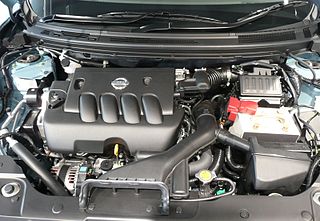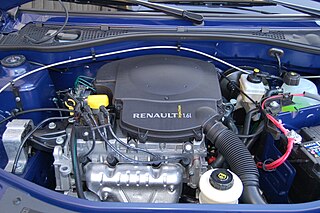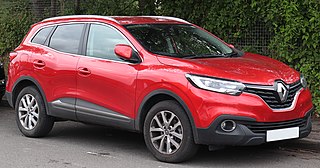
The Renault Clio is a supermini (B-segment) car, produced by French automobile manufacturer Renault. It was launched in 1990, and entered its fifth generation in 2019. The Clio has had substantial critical and commercial success, being consistently one of Europe's top-selling cars since its launch, and it is largely credited with restoring Renault's reputation and stature after a difficult second half of the 1980s. The Clio is one of only two cars, the other being the Volkswagen Golf, to have been voted European Car of the Year twice, in 1991 and 2006.

The Renault Mégane, also spelled without the acute accent as Megane, especially in languages other than French, and also known as the Renault Megavan for an LCV in Ireland, as the Renault Scala in Iran and as the Renault Mégane Grandcoupé for the saloon in Israel, Palestinian Authority and Serbia for certain generations, is a small family car produced by the French car manufacturer Renault for the 1996 model year, and was the successor to the Renault 19. The Mégane has been offered in three- and five-door hatchback, saloon, coupé, convertible and estate bodystyles at various points in its lifetime, and having been through four generations is now in its fifth incarnation.

The Renault Laguna is a large family car that was manufactured and marketed by Renault for 21 years in three body styles: hatchback, coupé, and estate. The first generation Laguna was launched in 1994, the second generation was introduced in 2000, and the third generation was built from October 2007 until 2015.

The Renault Scénic, also spelled without the acute accent as Scenic, especially in languages other than French, is a car which was produced by French car manufacturer Renault, the first to be labelled as a small multi-purpose vehicle (MPV) in Europe. The first generation was based on the chassis of the Mégane, a small family car. It became the 1997 European Car of the Year on its launch in November 1996. In May 2022 Renault announced it was discontinuing the standard Scénic with the Grand Scénic following shortly after. It was relaunched in 2024 as a fully electric vehicle called the Renault Scénic E-Tech which is the production version of the Renault Scénic Vision concept unveiled in 2022, with the production version to be unveiled at the 2023 Munich Motor Show on September 4.

The OM617 engine family is a straight-5 diesel automobile engine from Mercedes-Benz used in the 1970s and 1980s. It is a direct development from the straight-4 OM616. It was sold in vehicles from 1974 to 1991. The OM617 is considered to be one of the most reliable engines ever produced with engines often reaching over 1,000,000 km (620,000 mi) without being rebuilt and is one of the key reasons for Mercedes' popularity in North America in the 1980s, as it was powerful and reliable compared to other automotive diesels of the time. It is also a very popular choice for the use of alternative fuels, mainly straight or waste vegetable oil and biodiesel, although the use of these fuels may cause engine damage over time if not processed properly before use.

The Renault-Nissan MR engine family consists of straight-four 16-valve all-aluminium and water cooled automobile engines with variable valve timing co-developed by Renault and Nissan. Renault calls it the M engine. Other noteworthy features of this engine family include acoustically equal runner lengths and a tumble control valve for the intake manifold, a "silent" timing chain, mirror finished crankshaft and camshaft journals, and offset cylinder placement in an attempt for increased efficiency.

The HR is a family of straight-3 12-valve and straight-4 16-valve automobile engines with continuously variable valve timing, involving development by Nissan and/or Renault, and also Mercedes-Benz in the case of the H5Ht/M282. The designation of H engine is used by Renault, and M28x by Mercedes-Benz, to classify the family. There are three basic specifications of engine involving variations in engine architecture, or all-new architecture, with 72.2 mm (2.84 in), 75.5 mm (2.97 in) and 78 mm (3.07 in) bore diameter.

The Nissan Qashqai is a compact crossover SUV (C-segment) designed and produced by the Japanese car manufacturer Nissan since 2006. The first generation of the vehicle was sold as the Nissan Dualis in Japan and Australia, and Qashqai in the rest of the world. The second generation, launched in late-2013 for the 2014 model year, was not sold in Japan and was badged as the Qashqai in all countries it was sold, except in the United States, where it was rebadged as the Nissan Rogue Sport. Since the third and latest generation model launched in 2021, the Qashqai is available with hybrid powertrains.

The Renault Mégane Renault Sport is a series of high-performance hatchback models based on the Renault Mégane, produced since 2004 by the high-performance subsidiary company Renault Sport for its parent company Alpine, a subsidiary of Renault. The Mégane RS won awards such as "Best hot hatch" from What car? (2010–2014), "Highest placed non-supercar" in Evo's annual Car of the Year test 2011 and "Best hot hatch" from Top Gear.

The Renault Fluence is a compact sedan produced by the French automaker Renault. The car was produced until 2016 at the Oyak-Renault plant in Bursa, Turkey. It was produced until the end of 2018 in Santa Isabel, Argentina, for the Latin American market.

F Renault engine is an automotive internal combustion engine, four-stroke, inline-four engine bored directly into the iron block, water cooled, with overhead camshaft driven by a timing belt, and with an aluminum cylinder head, developed and produced by Renault in the early '80s, making its appearance on the Renault 9 and 11. This engine is available in petrol and diesel versions, with 8 or 16 valves.

The K-Type is a family of inline-4 automobile engines developed and produced by Renault since 1995. This is an internal combustion engine, four-stroke, with 4 cylinders in line bored directly into the iron block, water cooled, with overhead camshaft(s) driven by a toothed timing belt and an aluminium cylinder head. This engine is available in petrol and diesel versions, with 8 or 16 valves.

The Renault Koleos is a crossover SUV manufactured by the French manufacturer Renault over three generations. It is primarily manufactured in Busan, South Korea by Renault Korea.
The Nissan ZD30 engine family is a 3.0-litre inline-four cylinder diesel engine with a bore and stroke of 96 mm × 102 mm, that replaced the Nissan QD, BD and TD engines. At Renault it also replaced the Sofim 8140 engine and is the only truck diesel engine which remained with Nissan Motors when they sold Nissan Diesel to Volvo trucks in 2007.

The Nissan Primera is a large family car which was produced by the Japanese automaker Nissan from 1990 to 2007, for the markets in Japan and Europe. In Japan, it replaced the Auster/Stanza, and was exclusive to Nissan Prince Store locations. In North America, it was the entry level luxury sports sedan for the Infiniti brand. The word "primera" in Spanish means "first", in its female form.

The Renault Captur is a series of subcompact crossover SUVs manufactured by the French automaker Renault. The production version of the first one, based on the B platform, made its debut at the 2013 Geneva Motor Show and started to be marketed in France during April 2013. The Captur Concept was first shown at the 2011 Geneva Motor Show.
The Common Module Family (CMF) is a modular architecture concept jointly developed by car manufacturers Nissan and Renault through their Renault–Nissan–Mitsubishi Alliance partnership. The concept covers a wide range of vehicle platforms.

The Renault Kadjar is a compact crossover SUV (C-segment) manufactured and marketed by Renault. It was revealed at the 2015 Geneva Motor Show, with sales starting in April 2015 in Europe, and in 2016 in China.

The Nissan KR engine family consists of three and four-cylinder all-aluminum turbocharged gasoline engines in both 12-valve and 16-valve versions with a variable compression ratio and variable valve timing developed by Nissan.
















